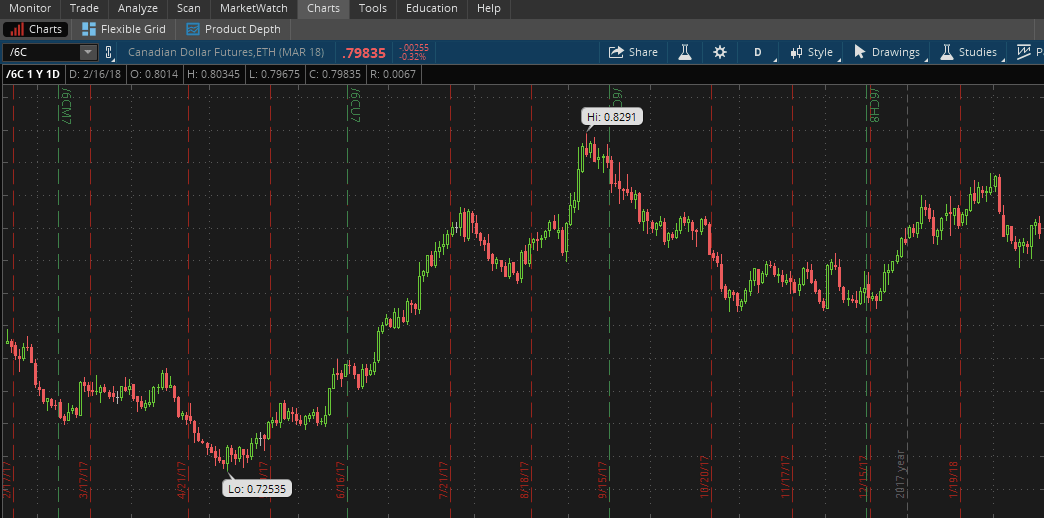Voltage weighted average price (VWAP) and moving voltage weighted average price (moving VWAP, or sometimes MVWAP) are types of weighted averages that include volume in their calculations. It is recorded directly on the price chart. VWAP is purely a day trading indicator – it will not appear on daily charts or more time compressions (eg, weekly, monthly).
A price hovering below the VWAP may indicate that the security is “cheap” or “value” on an intraday basis. On the other hand, a price above the VWAP may indicate that the security is “expensive” on an intraday basis. VWAP is also used as a barometer to fill trades. Volume is an important component related to market liquidity.
For example, if a long trade is filled above the VWAP line, this may be considered a suboptimal trade. Moving VWAP tracks the latest VWAP calculations over time, and thus essentially forms a moving average.
The duration can be adjusted to include as much or as little VWAP value as desired. Here is an image of the moving VWAP applied to the daily chart of the S&P 500 (pink line). It should be noted that VWAP and moving VWAP may not work on currencies / forex due to the fact that many software platforms do not contribute volume data in this asset class.
Calculate VWAP
VWAP is calculated through the following steps:
1. For each period, calculate the typical price, which is equal to the sum of the high, low, and close prices divided by three [(H + L + C) / 3].
One bar or candlestick is equal to one period. What this period is set up to the discretion of the trader (for example, 5 minutes, 30 minutes, etc.).
2. Take the normal price (TP) and multiply it by the volume (V), giving a value of TP * V.
3. Keep a running tabulation of the total TP * V and also the total running volume. This is additive and aggregates throughout the day.
4. VWAP is calculated with the formula: cumulative volume TP * V / cumulative This calculation, when run at each period, will produce a volume-weighted average price for each data point.
This information will be completed on the price chart and form a line, similar to the first image in this article. Moving VWAP simply adds some recent VWAP numbers and targets them in a user’s specific time period.
VWAP will be calculated automatically in one’s charting software. There should be no mathematical or numerical variables that require adjustment. On the moving VWAP indicator, one needs to set the desired number of periods.
Use of VWAP and Mobile VWAP
VWAP, as an indicator, is best for short-term traders who take trades that usually last only a few minutes to hours. As a long-term average, moving VWAP is more suitable for long-term traders who take trades that span days, weeks, or months.
Moving VWAP is a trend following indicator and works in the same way as moving average or moving average proxy, like moving linear regression. For those who use trend following as the cornerstone of their trading strategy, moving VWAP can be a viable indicator to integrate into one’s system. Price reversal traders can also use moving VWAPs. In such cases, it is recommended that one uses a crossover strategy.
The basic idea in the crossover strategy is to use the “fast” average to measure the trend when it crosses the “slow” average. To find price reversals in a timely fashion, it is recommended to use a shorter period for this average.
For example, your fast moving VWAP line can be set at 1-3 periods while your slow moving VWAP line can be set around 5-10 periods. This ensures that price acts quickly to diagnose a shift in an early trend before the majority of the move has passed and left a sub-optimal entry point. This approach will be discussed in the section below.
Trading Examples
As mentioned above, there are two basic ways to approach trading with VWAP – either trend trading or price reversals. We will start with trend trading to start.
Trend By Trading Patterns
As with any indicator, using it as the sole basis for trading is not recommended. We cannot simply follow the slope of a moving average indicator type and expect to trigger enough odds in someone’s favor.
Trend following is the basis of the most common strategies in trading, but it still needs to be used appropriately. This can mean taking signals from price action, chart patterns, other technical indicators, and/or fundamental analysis. This post is dedicated to technical analysis, so we will use moving VWAP in the context of another similarly themed indicator.
We will use a derivative oscillator, which runs between bullish periods and bearish periods when above and below zero, respectively. Our trading rules will be simple:
Old Trade
- The VWAP movement should be tilted positively
- Derivative oscillator above zero
Short Trade
- Moving VWAP should be negatively triggered
- The derivative oscillator is below zero
Exit Trade
- One of these two criteria is invalid
Example #1
Let’s look at an example of using the moving VWAP on the daily timeframe of the S&P 500. Since the positive moving VWAP line is declining throughout, we are biased towards long trades only. This comes on when the derivative oscillator is above zero, and shuts down when it is below zero. Trades are marked by “Buy” zones between vertical white lines. This resulted in four good-sized winners and one small loss.
Example #2
Here we apply this basic system to an ETF that tracks the coffee futures market (symbol NYSEARCA: JO ). We have one long trade and four short trades. This had a more mixed performance, yielding one winner, one loser, and three near-breaks.
Example of a Price Reversal Trade
A price reversal trade will be completed using a moving VWAP crossover strategy. The longer the period, the more old data there will be packed into the indicator. We want to minimize this to catch the reversal as early as possible, so we want to shorten the period.
We want a short time frame, but not so short that we end up with something that doesn’t make much sense and sends some false or ambiguous signals. In the case of moving the VWAP, we can lower the duration of the “fast” line to 1, if necessary.
 Our “slow” line can be at least 5 periods. To get an indication of when price might be stretched, we can pair it with other price reversal indicators, such as envelope channels. This indicator, as explained in more depth in this article, diagnoses when the price may be stretched.
Our “slow” line can be at least 5 periods. To get an indication of when price might be stretched, we can pair it with other price reversal indicators, such as envelope channels. This indicator, as explained in more depth in this article, diagnoses when the price may be stretched.
In order to ensure the fastest possible signal, we will use a tighter period (10) and use a standard deviation of 5. It does not make sense for the price to break the upper or lower precursors with these tight settings, which should theoretically improve reliability. So, to issue our rules for this system:
Old Trade
- The fast line (1-period) crosses the slow line (5-period) above
- The latest touch from the bottom band
Short Trade
- The fast line crosses the slow line
- The latest touch from the top band
Exit Trade
- The next crossover of the VWAP line moves to confirm the previous trend
Example
Let’s use this for the daily chart of the crude oil market. In the chart below, just before the first trade setup we see a momentum break that causes price to hit above the upper channel of the envelope channel.
Once the VWAP line moves across the bearish pattern, a short trade setup appears at this point (red arrow). This takes us down about 2%-3% before the “fast” moving VWAP line crosses over again to confirm the trend. This leads to an exit trade (white arrow).
Then we see the same situation. Price moves up and runs through the channel above the envelope channel. On each of the next two candles, it attacked the channel again but both rejected the level. When the fast-moving VWAP line crosses the slow line, this is a signal to take another one against the trend (red arrow).
The lines cross five candles later where the trade exits (white arrow). If the trade is opened and closed on each open and close candle, this trade will decrease even.
VWAP trading
VWAP is calculated intraday only and is mainly used in the market to check the quality of pricing or whether a security is a good value based on the daily timeframe.
If the price is below the VWAP, it may be considered a good price to buy. When the price is above the VWAP it may be considered a good price to sell. If we look at an example of a 5-minute chart on Apple (AAPL), a price below VWAP shows that Apple can be a reasonable value (or a long trade at one of these prices becomes a satisfactory quality).
Likewise, when the price runs above the VWAP, it can tell the trader that Apple is expensive on the intraday. If he plans to go long / buy the stock with the plan to hold it for the short term only, it may be better to wait. Obviously, VWAP is not a daily indicator that should be traded on its own. But it is one tool that can be incorporated into an indicator to help inform better trading decisions.
The conclusion
VWAP is calculated throughout the trading day and can be useful in determining whether an asset is cheap or expensive intraday. Traders may check the VWAP at the end of the day to determine the quality of their execution if they take a position on that particular security.
If their fill price is below the VWAP, this will be considered a plus (if the trade is a buy/long position). If the price is above the VWAP, this will be considered negative. VWAP restarts every trading day. Moving VWAP is a trend following indicator.
It combines the VWAP of several different days and can be adjusted to meet the needs of specific traders. Longer moving VWAPs are used by long-term traders to track multi-month or multi-year trends. It can introduce “noise” in the market for traders who are more concerned with long-term trends or cyclicality that may exist in certain markets rather than focusing on daily movements.
Price reversal traders may use VWAP moving crossovers to determine turning points in the market. Moving VWAP is very versatile and very similar to the moving average concept.








